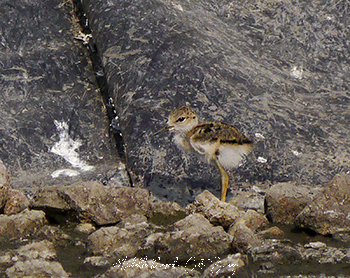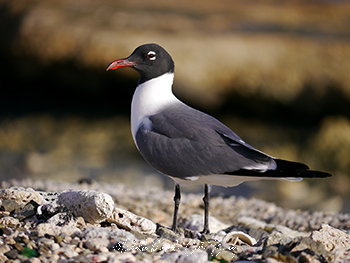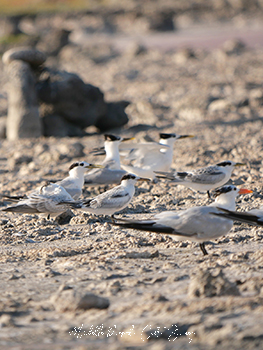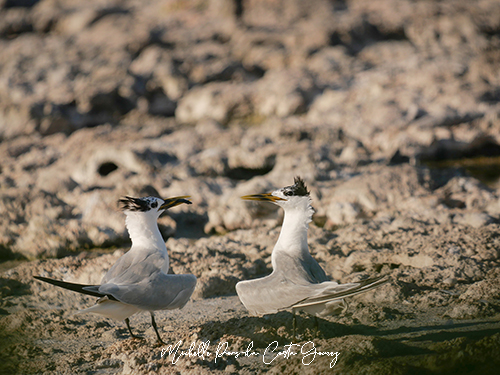Repost with Dutch translation from: Help make the seabird breeding season on Curacao a success! – Bird Watching Curaçao – HOME
This post is also available in: Dutch (below)
April, May, June, July and part of August are the months that mark the breeding season of seabirds on Curacao. From February onwards, the numbers of terns and laughing gulls on the island start to grow steadily. In other months they are still a bit more difficult to find, but from February onwards they can be spotted in ever-increasing groups at Playa Kanoa, Klein Curacao, Koredor and a number of other places along the coast. In April, the breeding rituals and nesting begin, a crucial period that we point out every year. And where you too can make a major contribution to making this a successful breeding season. Read on and help!
This article is about breeding activity on Curaçao. However, several species of terns and gulls also breed on Aruba and Bonaire and also face crucial dangers that have a huge impact on their breeding success!



Curaçao has the honour of being the scene of the breeding season of various seabirds including the Royal Tern, the Sandwich Tern, the Common Tern and the Least Tern. In addition, Laughing Gulls also breed on certain coastal zones of the island and there are frequent visits from Brown Noddies, Black Terns, Bridled Terns, Sooty Terns, Roseate Terns and other seabirds, which may not breed on our island but do need the fishing water to feed their young on Aruba, for example.

A short period of breeding activity
The breeding season is a relatively short season that runs from mid-April to the end of early August, depending on the species, but it is a very intensive season. The birds have to form breeding pairs that will lead to a successful breeding result. Partner rituals with complete dances to impress each other, the mating itself, laying the eggs and then hatching them to then help the young on the fragile path to adulthood, are all part of this process. Unfortunately, various seabirds are becoming less and less successful in this process and this is all too often due to careless human actions. Pollution is a major problem. The fact is that more and more chemicals end up in the sea and therefore also in the food that the birds eat, fish. This is a disaster, as certain toxins accumulate in the bodies of the parents and cause the eggshells of the eggs that are eventually laid to be so thin that they break when the adults sit on them. In addition, it is increasingly common for young birds to die because they ingest too much plastic. All the result of waste that ends up in the sea, on our islands but also elsewhere in the world, the pollution of the sea is a global problem. The adult birds catch fish, but can also mistake pieces of plastic that float just below the surface for fish. These are then ‘caught’ and fed to the young as fish. This blocks the gastrointestinal tract and the young will starve.
In addition, our own actions on land also ensure that fewer and fewer young reach adulthood. The main cause of this is the disruption of breeding areas. The locations that these animals need to successfully reproduce are being disrupted on an ever-increasing scale. Sometimes unconsciously because people are often unaware of the damage that is being caused. But the damage is also increasingly being done deliberately and sometimes even on purpose. People who are warned about the damage they are causing with their actions, curse you and deliberately do what has been kindly requested not to do for 2.5 months. With fatal consequences. Because the damage is immense: eggs trampled to pieces and defenceless young torn apart by dogs. A call for alertness is therefore appropriate.
Mating rituals

The seabird species mentioned, and with their various other species, start their breeding season in the month of April, something that only happens once a year. Successful reproduction depends on a good choice of partner, not only for strong genes in the offspring, but especially to successfully raise the young. A hungry young eats for two, and then you also need two parents to provide sufficient food. In April it is therefore very possible to spot these bird species while they are courting. In the case of terns and Black-necked stilts (Makamba), a whole dance ritual is performed by the partners that ultimately ends in mating. In the case of terns, gifts, in the form of small fish, are also handed over to strengthen the bond between the two partners.
After mating, the partners must find a suitable location to lay their eggs. All seabirds do this at locations that are not too far from the sea, such as the rugged coastline on the north coast (Playa Kanoa, Vlakte van Hato, Boka Patrick, Ascencion. Shete Boka), the coastline around inland waters such as Santa Martha, the Schottegat and Piscadera Bay, the islands that lie in the middle of the salt pans of Jan Thiel and the salt pans of Boka Samí, and on the walls of these salt pans. Klein Curaçao is also a popular place for these types of birds. And these are precisely the places that are increasingly being used for recreation.
Scouting
In the period from the end of April to mid-May, many species of terns and other seabirds are looking for an ideal breeding place to lay their eggs and raise their young. They do not come back to the same place every year, but look for the best place to nest every year. The breeding place must meet high requirements in terms of peace and quiet. A little disturbance is enough to make the animals decide to leave. That is why it is very important that no disturbing elements can be found at potential breeding locations during the ‘scouting’ period. And everyone who walks, cycles or walks the dogs in nature reserves can help a lot with that.
Nesting locations and an egg on the ground
Terns usually breed in large groups together (breeding colonies). The large number of birds not only provides protection, as more eyes see danger faster, but also reduces the chance of an egg or young being stolen, for example by a hungry Frigate bird or Caracara. The birds usually do not make nests of twigs or grass but simply lay their eggs on the ground, after which both parents take turns to sit on the eggs and incubate them or protect them from the excessive heat of the sun.
Not all birds nest in groups. The Makamba, for example, does not do this, but carefully chooses a spot between the limestone cliffs where the female lays the egg. Terns, on the other hand, do breed in larger groups. Once the eggs have hatched and the breeding colony looks like a disorganised crèche with chicks, the parents know how to find their young by sound and then regularly sit on top of them to ensure that they do not overheat from the sun.
The breeding colonies and the individual hatchers are extremely sensitive to disturbance and will abandon their eggs or chicks without returning at the slightest disturbance in the form of stray dogs, mountain bikers, rat visits, hikers or quad bikers. Resulting in a lost generation.
Keep the peace and quiet in breeding areas, be responsible!

Terns and other water birds that are starting their breeding season this year, which only takes place once, need absolute peace to find a suitable breeding location, lay and hatch the eggs and raise the young. That is why it is very important that users of nature areas and reserves that are located on the coast, behave responsibly and especially observe carefully whether there is courtship behaviour of terns, whether aggressive behaviour can be observed (in the form of closely and loudly skimming over the head, or coming directly towards you and deviating at the last moment), and whether there are certain large groups of seabirds sitting together. If you see this behavior, it is important to leave the area in question immediately and report the behavior together with the location via the Facebook page Bird Watching Curaçao in a private message, or via the ‘Ask your question’ button on www.birdwatchingcuracao.com. We can then issue targeted warnings for the areas that are being used as breeding locations this year.
Keep your dog on a leash!
In addition, we request everyone who walks dogs in coastal areas to keep all dogs on a leash until the end of July at least and if breeding activity is observed somewhere, to not walk there until the end of July. It is very important that quad bikers do not drive through the areas mentioned. We also ask mountain bikers and hikers to be vigilant and to avoid areas where breeding activity can be seen.
The areas where caution is necessary are: the Hato plain (along the coast), along the north coast from Ascencion to Westpunt, the salt pans of Jan Thiel (including the islands), the salt pans of Boka Samí, the salt pans of Jan Kok, the coastline along inland waters such as Sint Jorisbaai, Fuik and Groot Santa Martha and Klein Curaçao.

Help zeevogel-broedseizoen op Curaçao een succes te maken!
April, mei, juni, juli en een deel van augustus zijn de maanden die het broedseizoen van zeevogels op Curaçao markeren. Vanaf februari beginnen de aantallen sterns en lachmeeuwen op het eiland gestaag te groeien. In andere maanden zijn ze nog wat moeilijker te vinden, maar vanaf februari zijn ze in steeds groter wordende groepen te spotten bij onder andere Playa Kanoa, Klein Curaçao, Koredor en nog een aantal plekjes langs de kust. In April beginnen de voortplantingsrituelen en het nestelen, een cruciale periode waar we elk jaar op wijzen. En waar ook jij een grote bijdrage aan kan leveren om dit een succesvol broedseizoen te maken. Lees en help mee!



Curaçao heeft de eer het toneel te zijn van het broedseizoen van verschillende zeevogels waaronder de Koningsstern, de Grote stern, de Visdief en de Amerikaanse dwergstern. Daarnaast broeden ook Lachmeeuwen op bepaalde kustzones van het eiland en zijn er veelvuldig bezoeken van Brown Noddy’s, Zwarte sterns, Brilsterns, Bonte sterns, Dougall’s sterns en andere zeevogels, die dan wel niet broeden op ons eiland maar het viswater wel nodig hebben om hun jongen op bijvoorbeeld Aruba te kunnen voeden.

Een korte periode van broedactiviteit
Het broedseizoen is een relatief kort seizoen dat loopt vanaf half april tot en met eind begin augustus, afhankelijk van de soort, maar het is wel heel intensief seizoen. De vogels moeten namelijk koppels gaan vormen dat tot een succesvol broedresultaat zal moeten leiden. Partnerrituelen met complete dansen om indruk op elkaar te maken, de paring zelf, het leggen van de eieren en deze daarna uitbroeden om vervolgens de jongen te helpen op het broze pad naar volwassenheid, maken allemaal deel uit van dit proces. Helaas zijn verschillende zeevogels steeds minder succesvol in dit proces en dat komt maar al te vaak door onzorgvuldig handelen van de mens. Vervuiling is een groot probleem. Het feit is dat er steeds meer chemicaliën in zee terecht komen en daarmee ook in het voedsel dat de vogels eten, vis. Dit is een ramp, aangezien bepaalde gifstoffen zich opstapelen in de lichamen van de ouders en ervoor zorgen dat de eierschalen van de eieren die uiteindelijk gelegd worden, zo dun zijn dat ze breken als de volwassen dieren erop gaan zitten. Daarnaast komt het steeds vaker voor dat jongen dood gaan doordat ze teveel plastic binnen krijgen. Allemaal het gevolg van afval dat in zee terecht komt, op onze eilanden maar ook elders in de wereld, de vervuiling van de zee is een globaal probleem. De volwassen vogels vangen visjes, maar kunnen ook stukjes plastic die net onder het wateroppervlakte drijven aanzien voor vis. Deze worden dan ‘gevangen’ en als een visje aan de jongen gevoerd. Hierdoor verstopt het maagdarmstelsel en zal het jong verhongeren.
Daarnaast zorgt ook ons eigen handelen op het land ervoor dat er steeds minder jongen volwassen worden. De hoofdoorzaak hiervoor is verstoring van broedgebieden. De locaties die deze dieren nodig hebben om zich succesvol voort te planten worden op steeds grotere schaal verstoord. Soms onbewust omdat men zich vaak niet bewust is van de schade die veroorzaakt wordt. Maar de schade wordt ook steeds vaker welbewust gedaan en soms zelfs expres gedaan. Mensen die gewaarschuwd worden voor de schade die ze met hun handelen veroorzaken, schelden je de huid vol en doen expres toch wat vriendelijk is gevraagd om 2,5 maanden lang niet te doen. Met fatale gevolgen van dien. Want de schade is immens: kapot getrapte eieren en door honden verscheurde weerloze jongen. Een oproep tot alertheid is dan ook op z’n plaats.
Partner rituelen

De genoemde zeevogelsoorten, en met hun verschillende andere soorten, beginnen in de maand april aan hun broedseizoen, iets dat maar één keer per jaar gebeurd. Een succesvolle voortplanting is afhankelijk van een goede partnerkeuze, niet alleen voor sterke genen in het nageslacht, maar vooral ook om de jongen met succes groot te brengen. Een hongerig jong eet voor twee, en dan heb je ook twee ouders nodig om voldoende voedsel te leveren. In april is het dus heel goed mogelijk om deze vogelsoorten te spotten terwijl ze aan het baltsen zijn. Bij sterns en bij steltkluten (Makamba) wordt er een heel dansritueel opgevoerd door de partners dat uiteindelijk eindigt in de paring. Bij sterns worden er ook cadeautjes, in de vorm van kleine visjes, overhandigd om de binding tussen de twee partners te versterken.
Na de paring moeten de partners een geschikte locatie vinden om hun eieren te leggen. Alle zeevogels doen dat op locaties die niet al te ver van de zee af liggen, zoals de ruige kustlijn aan de noordkust (Playa Kanoa, Vlakte van Hato, Boka Patrick, Ascencion. Shete Boka), de kustlijn rondom binnenwateren als Santa Martha, het Schottegat en Piscaderabaai, de eilandjes die midden in de zoutpannen van Jan Thiel en de zoutpannen van Boka Samí liggen, en op de wanden van deze zoutpannen. Ook Klein Curaçao is een geliefde plek voor dit soort vogels. En laat dit nou net de plekken zijn die steeds intensiever gebruikt worden voor recreatie.
Scouting
In de periode van eind april tot midden mei zijn veel soorten sterns en andere zeevogels op zoek naar een ideale broedplek om hun eieren te leggen en hun jongen groot te brengen. Ze gaan niet elk jaar op dezelfde plek zitten maar zoeken jaarlijks het beste plekje op om te nestelen. De broedplek moet aan hoge eisen voldoen in de zin van rust. Een beetje verstoring is dan ook genoeg om de dieren te doen besluiten om weg te gaan. Daarom is het van groot belang dat in de ‘scouting’ periode geen verstorende elementen te vinden zijn op potentiële broedlocaties. En daar kan iedereen die wandelt, fietst of de honden uitlaat in natuurgebieden een flinke hand mee helpen.
Nestlocaties en een ei op de grond
De sterns broeden meestal in grote groepen bij elkaar (broedkolonies). Daarbij zorgt de massa niet alleen voor bescherming, meer ogen zien namelijk sneller gevaar, maar ook voor de verkleining van de kans dat een ei of jong gestolen wordt, door bijvoorbeeld een hongerige Fregatvogel of Kuifcaracara. De vogels maken meestal geen nest van takjes of gras maar leggen hun eieren gewoon op de grond, waarna beide ouders van beurt wisselen om op de eieren te zitten en deze uit te broeden of juist te beschermen tegen de overdadige hitte van de zon.
Niet alle vogels nestelen in groepen. De Makamba doet dat bijvoorbeeld niet, maar kiest zorgvuldig een plekje tussen de kalkrotsen waar het vrouwtje het ei legt. Sterns daarentegen broeden wel in grotere groepen. Als de eieren eenmaal uitgekomen zijn en de broedkolonie eruit ziet als een ongeorganiseerde crèche met kuikens, weten de ouders hun jongen aan de hand van geluid terug te vinden en gaan dan regelmatig bovenop ze zitten om te zorgen dat ze niet oververhit raken door de zon.
De broedkolonies en de individuele broeders zijn extreem gevoelig voor verstoring en zullen bij de minste of geringste verstoring in de vorm van loslopende honden, mountainbikers, wandelaars of quadrijders hun eieren of kuikens verlaten zonder terug te komen. Met een verloren generatie als gevolg.
Bewaar de rust in broedgebieden, wees verantwoordelijk!

Sterns en andere watervogels die in de komende aan hun broedseizoen beginnen, dat slechts 1 keer per jaar plaats vindt, hebben absolute rust nodig voor het uitzoeken van een geschikte broedlocatie, het leggen en uitbroeden van de eieren en het groot brengen van de jongen. Daarom is het van groot belang dat gebruikers van natuurgebieden, die zich aan de kust bevinden, zich verantwoordelijk gedragen en vooral goed observeren of er baltsgedrag is van sterns, of er agressief gedrag geconstateerd kan worden (in de vorm van rakelings en met veel geluid over het hoofd scheren, of direct op je af komen en op het laatste moment afwijken), en of er bepaalde grote groepen zeevogels samen zitten. Indien je dit gedrag ziet, dat is het belangrijk om direct uit het betreffende gebied weg te gaan en het gedrag samen met de locatie te melden via de Facebook pagina Bird Watching Curaçao in een private message, of via de ‘Ask your question’ knop op www.birdwatchingcuracao.com. We kunnen dan gericht waarschuwingen uiten voor de gebieden die dit jaar worden gebruikt als broedlocaties.
Hou je hond aan de lijn!
Daarnaast verzoeken we iedereen die honden uitlaat in kustgebieden om in ieder geval tot eind juli alle honden aangelijnd te houden en indien er ergens een broedactiviteit wordt geconstateerd daar in ieder geval niet meer te wandelen tot en met eind juli. Het is van groot belang dat quadrijders niet door de genoemde gebieden rijden. En ook mountainbikers en hikers vragen we oplettend te zijn en gebieden waarin broedactiviteit te zien is te mijden.
De gebieden waar zorgvuldigheid noodzakelijk is, zijn: de vlakte van Hato (langs de kust), langs de noordkust van Ascencion tot en met Westpunt, de zoutpannen van Jan Thiel (inclusief de eilandjes), de zoutpannen van Boka Samí, de zoutpannen van Jan Kok, de kustlijn langs binnenwateren als Sint Jorisbaai, Fuik en Groot Santa Martha en Klein Curaçao.